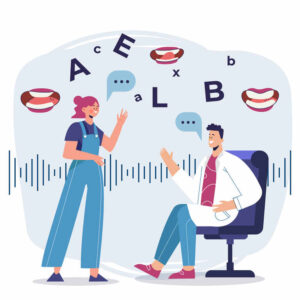In this blog, we will focus on the advantages and disadvantages of informal communication with real examples. The article further includes the characteristics and types of informal communication with the frequently asked question on informal communication.
What is informal communication?
Informal communication, also known as grapevine business communication is casual and unofficial in nature. Informal channels of communication such as informal oral communication and informal written communication are used to exchange information between two or more individuals without conforming to official rules and prescribed formats.
Compared to formal communication, informal methods of communication help in building strong networks, and business connections. This communication type is vital for effective management, coordination, and maintaining healthy work relations.
Informal business communication can be internal and external. Informal internal communication type refers to an interaction between employees using emails, face-to-face conversations, phone calls, informal business reports, etc. External informal communication implies interactions with third parties such as suppliers, investors, customers, etc.
Further Reading: What is Informal Communication: Examples, Types & Characteristics
Advantages of Informal Communication
Successful managers realize the importance of informal communication in a business. It is one of the most effective types of business communication. The purpose of informal communication is to convey information in a casual and laid-back manner.
The merits of informal communication are:
1) Interpersonal Relationships:
Informal communication creates an environment of personal bonding between employees. This type of communication system between workers helps in stronger coordination for tasks, motivation, and reducing boredom in routine tasks.
Superiors and subordinates can develop healthier working relationships by communicating through conversations about non-work related topics to add human elements to a business environment.
Find out more about communication and conversation on our blog.
2) Speed:
Due to the absence of channel barriers prevalent in formal communication channels, messages can travel very fast in informal communication. With social media systems and instant messaging technology available, it is possible to deliver information to the receiver in any geographical location at a fast speed.
3) Flexible form of communication:
Informal communication networks do not require employees to follow formalities. This eliminates communication from being rigid. An employee can directly communicate with a subordinate or superior using different channels in the communication process such as written communication, and verbal communication.
Related Reading:
Merits and demerits of written communication
4) Getting recommendations:
Informal communication provides a great platform for providing recommendations. For maximum efficiency in growing a business, it is vital for colleagues, superiors, and subordinates to brainstorm together. Together they can generate new ideas, suggest solutions for problems, develop new strategies, etc.
5) Increased job satisfaction:
An organization with a solid informal communication system thrives as it allows its employees to feel engaged. It increases motivation, and enthusiasm and boosts job satisfaction by creating a work environment that is inclusive, friendly, and non-robotic.
6) Satisfies social needs:
Human interactions rely heavily on informal communication. A work environment that encourages employees to freely express their ideas and viewpoints leads to higher levels of coordination, teamwork, and efficiency in work output.
Disadvantages of Informal Communication
Informal communication is an effective form of communication for any business. However, there are some demerits associated with it.
The limitations of informal communication are as follows:
1) Misinterpretation:
Due to a lack of official processes and rules, the message in informal communication can be distorted. The original message can be misinterpreted and this can give rise to misunderstandings and arguments between or among employees and managers.
2) Lack of accountability:
There are no records maintained in informal communication. This makes it difficult to trace the original source of information. Individuals can also deny conveying harmful and false information and deny accountability.
3) Informational leaks:
Confidential information can be leaked through informal channels of communication. This causes instability in the organization. The integrity of any business relies on having trust in its employees. Information leaks can even cause the business great monetary losses.
4) Spread of rumors:
Rumors spread predominantly through informal channels of communication. It is difficult to trace the source of rumors and false information due to a lack of control over communication channels. This is also harmful to the organization.
5) Unreliable:
A lot of times information received from informal channels can be unreliable. It has to be verified and confirmed first before taking it into consideration. This process can be time-consuming and require a lot of effort to get accurate information.
6) Errors in carrying out tasks:
Employees are more likely to commit errors at work if they rely too heavily on informal communication. As no formal rules and processes are followed, it is possible for employees to misinterpret job duties and tasks.
Example of Informal Communication
Example 1.1
JIM: Who’s the tall woman next to Barbara?
CHARLES: That’s her new line manager. Didn’t you meet her at daily meeting?
JIM: No, I wasn’t there in the meeting.
CHARLES: Oh! Then let me introduce you to her now. Mary, this is my collegue Jim.
MARY: Hi, Jim. Nice to meet you.
JIM: You, too. Would you like to work together on our next project?
MARY: Sure, count me in the team.
Example 1.1 shows an informal introduction conversation between two employees Jim and Charles and a new line manager Mary.
Example: 2.1
JANE: Hi, Helen! How’s it going?
HELEN: Fine, thanks – and you?
JANE: Just fine. Where are you off to?
HELEN: To the board room. I’ve got a sales meeting. Ugh.
JANE: Oh, no. Well, I’ll see you later then. Good luck!
HELEN: Thanks. See you later.
Example 2.1 shows an informal communication between Jane and Helen about their daily routine in the office.
Benefits of using informal communication in an organization
Informal communication in an organization refers to the transmission of information, ideas, and opinions through unofficial channels, outside of the formal organizational structure. While formal communication channels, such as official memos and meetings, play a crucial role in conveying important organizational information, informal communication offers several benefits that complement the formal framework.
1/ Employee Engagement and Satisfaction: Informal communication enhances employee engagement and satisfaction by fostering a sense of belonging and inclusion. When employees experience a sense of connection with their colleagues and are given the freedom to express themselves, their motivation and investment in their work tend to increase.
2/ Flexible and adaptive communication: Informal communication is typically more flexible and adaptable compared to formal channels. It enables individuals to express themselves freely and openly, adapting their communication style to suit the situation.
3/ Enhanced innovation and creativity: Informal communication channels frequently foster the exchange of a wide range of ideas and perspectives. Employees feel more comfortable sharing unconventional or creative thoughts, leading to increased innovation and problem-solving capabilities within the organization.
Advantages and disadvantages of informal groups
Advantages of Informal Groups:
- Enhanced collaboration and teamwork: Informal groups often develop strong bonds and trust among their members, leading to improved collaboration and teamwork.
- Social support and motivation: Informal groups can offer emotional support and motivation to their members. In times of stress or challenges, group members can provide encouragement, guidance, and a sense of belonging, which can positively impact job satisfaction and employee well-being.
Disadvantages of Informal Groups:
- Lack of accountability: Informal groups may operate outside the formal structure of the organization, leading to a lack of clear roles, responsibilities, and accountability. As a consequence, this can lead to confusion, unnecessary efforts, or the neglect of crucial tasks.
- Distraction and Loss of Productivity: Excessive reliance on informal groups for socializing or non-work-related activities can lead to distractions and a decline in productivity. It is important to strike a balance between fostering a positive work environment and ensuring that work responsibilities are prioritized.
Types of Informal Communication
The types of informal communication networks are as follows:
1) Single Strand Network: Under a single-strand network, at any given time there is only one sender and one receiver of information. Information is passed from one person to another and so on.
2) Gossip Chain Network: In a gossip chain network, the sender communicates information to multiple individuals as part of the same network. The members of the network then communicate with each other informally to discuss the information they received.
3) Probability Chain Network: In this type of informal communication, information is transmitted randomly from one person to another. The sender can randomly select a person in the network to deliver their message. This results in a flow of communication from individuals selected based on probability.
4) Cluster Chain Network: In a cluster chain network, the sender delivers a message to a pre-selected network of people. Out of this network, the source of the message may select individuals to carry the same message to other networks. This allows the information to spread to all persons in the communication network.
Characteristics of Informal Communication
The features of informal communication are listed as follows:
1) Multiple Directions: Informal communication can flow in any direction. It can be vertical which includes upward communication & downward communication and horizontal communication, etc.
2) No records: Informal communication is mostly done in oral form. Therefore, it is difficult to have documented proof of it. This makes it difficult to trace the source of information.
3) Spontaneous: Informal communication is not planned or routine in nature. It can happen anywhere and at any time.
4) Free from formalities: Informal communication does not conform to prescribed rules and organized formats. The sender can convey their ideas and message in a free-flowing and casual manner.
5) Personal bonding: Informal communication channels boost teamwork, network building, and increased enthusiasm among the employees in a company.
Frequently Asked Questions
Q1) What are the advantages and disadvantages of grapevine communication?
Ans: Advantages of grapevine communication:
- Fast travel of information.
- Managers get feedback and recommendations from subordinates.
- Stronger bonding between employees.
- Flexible form of communication.
Disadvantages of grapevine communication:
- Information can be misinterpreted and misunderstood.
- May provide unreliable information.
- Difficult to track the source of information.
- Informational leaks can occur.
Check out our detailed article on the advantages and disadvantages of grapevine communication.
Q2) What is the advantage and disadvantage of formal communication?
Ans: A prime advantage of formal communication includes passing relevant information at various levels of the departments which leads to effective control over business operations. However, the limitation of formal communication includes delays in decision-making as the information has to pass through an established framework set by the organization.
Related Reading:
Advantages and Disadvantages of formal communication.
What is formal communication: example, types and characteristics
Q3) What are the disadvantages of downward communication?
Ans: A common disadvantage of downward communication is a distortion of information. As information travels from superiors to subordinates, it can lose accuracy due to misinterpretation. It can also be time-consuming and receive resistance from subordinates due to downward communication being authoritative in nature.
Related Reading: For more, read our blog on advantages and disadvantages of downward communication.
Q4) What are the advantages and disadvantages of informal organizations?
Ans: The advantages of the informal organization are:
- Puts emphasis on relationships and people
- Does not follow bureaucratic order
- Flexible in nature
- Facilitates leadership skills among employees
Disadvantages of the informal organization are:
- Unclear objectives
- Absence of rules and restrictions
- No unity of command
- May be unstable



